User:Vera/minor/Research document
Contents
- 1 What did we knit?
- 2 Preface/introduction
- 3 Abstract
- 4 Central Question
- 5 Relevance of the topic
- 6 Hypothesis
- 7 Research Approach
- 8 Key References
- 9 Literature'
- 10 Experiments
- 11 Insights from Experimentation
- 12 Artistic/Design Principles
- 13 Artistic/Design Proposal
- 14 Realised work
- 15 Final Conclusions
- 16 Bibliography
What did we knit?
A essay/ Research document about machines, objects and human feelings.
We found a knitting machine: the Open Knit [1],[2]. We used this machine and adapted it for our purposes. This machine is only able to knit technically simple tube patterns. However, the idea that a machine is able to copy the result of a human craft. Actually a lot of people are unaware that most knitted clothes are made bye knitting machine, who knits all your cloths. Please take a closer look at your one cloths.
In this essay I do not want to tell you about how to knit, but the charm of a knitting machine as an object and as a human made machine. In this way we can investigate and create some empathy between human kind and machines.
Preface/introduction
From graphic design to digital craft. Previously I have written in ‘my craft’ that I was afraid for computers. They didn’t do what I wanted, maybe because I was ignorant on how to operate one. When I understood better how to deal with the computer I became less afraid and now I feel comfortable with digital objects. Before this art academy I did not have WhatsApp, a mobile phone, or internet at my home. Not because I didn’t want it but I didn’t care about these intangible things. Always I was working with physical materials to make collages, lino’s or string beads. I really like to have material in my hands and have some control over it, also with materials you have fast and quick prototypes allowing for quick visual results. But in this second school year I discovered the plotter. The plotter was the first digital application for which I had some intuition. It created this blurry and glitchy appearance: just what I was looking for. It has completely changed my mind on what I could do with digital technology and increased my desire to work with it. After this experience I felt more confident to work with electronical machines.
Also I read a lot, because I like reading a lot and especially Dutch or Flamish literature. But also Thomas More`s Utopia. [3] In this project I rediscovered myself as a reader because I found so many interesting books about human- machines and object relations. Especially: Design Noir: The Secret Life of Electronic Objects by Anthony Dunne and Fiona Raby [4] and Hertzian and Tales by Anthony Dunne [5]and W. Benjamin`s - the work of art in the age of mechanical reproduction:[6]
My interest in books exceeded the speed with which I could read them. All in all however I found many interesting new ideas to facilitate what I wanted to do. In the end however the work is a practical application existing outside of the theory of books.
In this minor I was able to make something which I never thought I could make, namely an art object on the cutting edge of robotics, electronics and human craft. I’m happy with the results but there are still way more things to learn and I am still at the early stages of developing these robotics.
Abstract
We adopted a machine, a knitting machine. The knitting machine was left alone somewhere in the school. A machines of which a lot of people asked what is could do? Maybe because it doesn’t look like the real craft anymore. Maybe because it doesn’t looks like a knitting machine? So why do we have machines in life that don't look any more like what it supposed to be, how did we humans use it before? Objects, products, machines keep getting more distant to human design and are starting to be more about the ritual and not how it works or makes things.
For example, the knitting machine. The knitting machine is a machine that is not at all like the human craft. Before the Knitting machine we had the knitting human. We know our craft by that. We forget how big this simple thing is and how big it is on our growing industry.
So what if we tried to re-establish the link between human intuition and the machine`s working mechanism. Can we make our machines be intuitive and logical for human perception again? To dream about such an intuitively understandable machine is to use the original human craft as a starting point and adapt the industrial machine accordingly. In this way machines will be able to have a more natural place in our homes and life. People will no longer have to be an expert to understand what my knitting machine would be for.
Central Question
What is this robotic knitting machine?
Relevance of the topic
The world where we humans live in grows. It is growing when it come to humanity, technology, and economy. There has been a constant trend to make things bigger and bigger, never less. When we talk about the future it has to grow. Of course, humans grow as well so it makes sense that we want everything around us to grow too. When we work with technology or machines they can help us in this. This shows we have this belief in technology: technology will help us live prosperous lives and is able to solve many of our problems. But it doesn’t mean that the technology will save us entirely. In Design noir: by Anthony Dunne & Fiona Raby (Dunne & Raby, 2001, pp. 6-7) [7]this utopian belief is put forth as well. They explain that technology could be able to be the solution for every problem.
This belief in technology has caused generations of ever growing and swiftly changing industries. In our minds there are also things that seem to only change slowly like knitting, which has been the same for generations. Even if everything has been digitalized the fabrics in knitting, as in the manual craft and the knitting machines still use the same principles. At this time you may wonder why we talk about this granny thing buy you may not have realized that the whole world has knitted clothes. Look a bit closer to your own clothing.
Probably 70% of your closet is knitted. But do you know how knitting truly works? That we had a big immigration of the textiles industry to Asia where a lot of children works in the industry? All this to give you cheap knitted clothing. Now, all knitted clothing is produced using the same machines. Even if everything surrounding the industry has changed the act of knitting itself has not. You have the granny-style knitting with 2 needles. and 2 systems of machine knitting. What we want to do is not make a knitting machine, but show the gap between human craft and machine production.
“Our fine arts were developed, their types and uses were established, in times very different
from the present, by men whose power of action upon things was insignificant in comparison
with ours. But the amazing growth of our techniques, the adaptability and precision they have
attained, the ideas and habits they are creating, make it a certainty that profound changes are
impending in the ancient craft of The Beautiful. In all the arts there is a physical component
which can no longer be considered or treated as it used to be, which cannot remain unaffected
by our modern knowledge and power. For the last twenty years neither matter nor space
nor time has been what it was from time immemorial. We must expect great innovations to
transform the entire technique of the arts, thereby affecting artistic invention itself and perhaps
even bringing about an amazing change in our very notion of art.” - Paul Valéry, Pièces sur L’Art, 1931 or 1928 [8] [9]
Le Conquete de l’ubiquite
The relevance to the topic is also to see the gap between human and machines. With the gap I mean that we give machines a place and a roll in our lives but there is distant between the will of the machine and the user of this machine. The machine have to do what he have to do and if it’s not working it is his the machines fault. Such a wrong thing to think. The machine does exactly what you want but when you tell, make, it differed the machine will behave differently on the human. The human will give it a place in in their minds. I think it is just a feeling what the human have with this machine. Where it is used for and where the machines are.
Sun Yuan and Peng Yu - Can’t Help Myself[10]:
a machine how clean all the time without making it clean.
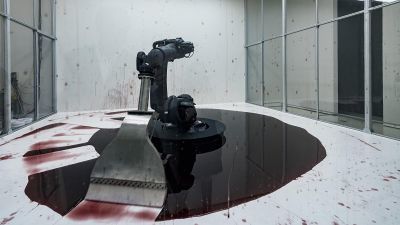
“The machine is incapable of preforming any task that is beyond the human Experian’s. What human’s fears is the unknown, if it is known it can be call the future. “
We look at the knitting part of the machine a very human thing to do. We think machines are smart, able to do everything what we want. But why? We have to make to teach and create this machines. And no, they don’t want to save our lives because there not able to do it. It is a Notopia for us. We live with the machines and the machines not with us? Why not.
Can we have some kind of emotional bond with machines? Can we sympathize with it? We adore objects for many years now, for many centuries. We live for that thing this unknowing thing. We started to worship this. like trees, the sun, or objects which humans make. They make story’s and give it natural powers and so the objects get an aura around them. This aura essentially comesfrom the human perspective of living. The aura is created by us human. We constantly change the way in which we see art, objects and machines. We can see this art, machines, objects. outside, inside, in books, on phones, on a picture, on the internet. Everywhere. And we can create differed perspective of feeling in our heads, colour, sympathy and empathy. When you want to have some empathy all you have to do is to see this aura, go to this artefact. Feel, see and create your own relation with it.
The technology is maybe the next unknowing step and we humans create our own stories using this machine. We could lose control over machines and what if the machines would start to be smarter than us? Or make decisions without our permission?
But why shouldn’t we fascinate about when the impossible is possible. What if this robotic knitting machine could be made? It is human to think that everything is working in theory of prototypes. But there is where everything start from, it could be? A fascination, a imagination, a speculation of something is a start for everything what you want to create. And we want to make a knitting machine, which acts like a human and obeys all the rules of creating safe machines. Maybe a human can build a relation with such a machine and give it some love and create more empathy. Then we could create a humane machine.
While working we also developed some empathy for the abandoned knitting machine. It felt as if he needed to show itself and what it went through. He did not have a lot of potential but his look was enough. When we used it to make a first DIY design the result was pretty crappie and not very complex. The people in school however told us it was a crazy machine. They didn’t think it looked cool. After this whole DIY knitting machine (rest of explanation is on the wiki) we wanted to create our own knitting machine.
As we go further into the future, we will have more machines, objects, things what will make our lives easier. We have machines that can recreate crafts. Only the thing is who knows about a craft as it is now after 100 years? So Suzanne and I speculated on what a knitting machine would look like if we left it to the human imagination. Using this principle, we created our own machines.
We want the machine to fit in our human life’s. we want to have an emotional bond with it because we created it and give it our love. It gave us our neutral powers which is something that gives us power to create the machine in turn and make it better and better. Just as with the DIY machine. People around us asked us: “what is this crazy machine and did you make this?” On its own it created without our knowing an aura of itself and a power, as fetishism. This fetishism a human-made object that has power over others. We look with our human perspectives to the object/machine. And in this way give power to an object. The human expressed real relations of power among the participants in ritual. This ritual is not only described in the fetishism but also by Walter Benjamin in his essay “the work of art in the age of mechanical reproduction”:
At the time, art reacted with the doctrine ofl'art pour l'art, that is, with a theology of art. This gave rise to what might be called a negative theology in the form of the idea of 'pure' art, which not only denied any social function of art but also any categorizing by subject matter. (In poetry, Mallarme was the first to take this position.)
An analysis of art in the age of mechanical reproduction must do justice to these relationships, for they lead us to an all-important insight: for the first time in world history, mechanical reproduction emancipates the work of art from its parasitical dependence on ritual.[11](Benjamin, 1936, pp. 217-220)
The relation of our machine what we make have also a lot of relations though the book of W. Benjamin. Even though the book is written in 1936 it talks about when art can be said to be art and how the aura contributes to this. Is art art when you see it in the real world, when you see it in a book? When is is written down? When are you the closed though the art and yourself.
The reason for adopting the KNIT is that we try to look from the perspective of the machine, the knitting machine`s thought the human and the the human thought the knitting machine also this in a group space. This relevance to it is the growing part of it how it will fit in a human and machine space for now and over many years. And how will the human create its own ritual between the machine as an art object and one`s own feelings. We can make a hypothetis how it will be, but when we present it at the expo we will never know how the human will react to the machine in reality.
Hypothesis
It could be that the robot knitting arm is not able to work, or maybe it is too slow and dysfunctional to work efficiently as a machine. I can tell you it is dysfunctional for sure and also not able to knit but we are still working on it, so at least is is pretending to be knitting. We hope that the human sympathizes with the machine and can recognize it as a machine that is knitting. We hope also that humans realize that this is not the way to knit mechanically. This will depend on whether they have an appropriate consciousness of the systems. Possibly they do not, as they never had any interest in knitting because there are too many distends between generation, technology. ‘To be human is to refuse to accept the given as given’ (Dunne & Raby, 2013, pp. 33-34)[12]
This hypothesis is also that possibly they do recognize it is knitting. But is is also a critical reflection of humans themselves. We also have expectations of this machine. Of course we talked about our conceptual theory. When we had a knitting machine which is working as we want in our desires with machines. Also we talk about our relation to it and how we human both think differently about this machine.
My hypothesis is that during this week I created an emotional bond with this machine. I handle it with care and give it soft blankets around it otherwise I`m afraid it might break. When I’m home I take the blankets of and place it on my windowsill, so it has something to look at.
When we have the expo the machine will definitely not be as good as I hoped it would be. It has to do with machines never being truly finished and the time pressure to work until the expo is due. Every time I`m writing machine it feels as if we`re talking about a big metal object without any softness in it.
I hope at least that human can also create a band with it. I think they will look at it in the first place if it is only something what move and later they realised it is a knitting machine. I hope that the human look long enough to feel a bit of awareness because the knitting machines is behaver there very personally. I hope to see at the expo that the human will sympathize with the ‘machine’ and give it some help because it’s dysfunctionality. Will the machine allow to be helped by humans? I hope and think that the visitors will be fascinated by the fact it is moving and later on will think about what it was actually trying to do. In the end I hope they will maybe give the inanimate machine a bit of help, or just wait till it doing his own thing.
Research Approach
We started with the knitting machine as a basis because Suzanne and I are both fascinated with knitting. This fascination comes from our different backgrounds, my background as graphic designer, who also loves fashion, not fashion but the materials of fashion. Of course for knitting. My grandma and mother are very good knitters they don’t even need machines in their life to create incredible knitting pieces. My mother is also a classic painter and creates a lot of patterns with knitting. But even we look only to the end result we never look at the machine who is doing most of the work.
What we did is by creating our one machine to work with though other machines, this machines where the Brother KH-900 and the OpenKnit (the opesource DIY). The research released of our one fascinates by knitting. But we didn’t know till now there what a hidden story in it. The story of a machine as a piece of art. Every time we think what the knitting machine produce have to be the end result. But definitely not when we work on the OpenKnit, and human ask us every time the same question. What is this machine? The human by us in school bring on the idea to create something what have attention.
We work by define and design our research by human questions, talks, thoughts and books about machines/humans and objects in human’s life. By working with opinions of humans and books work very well to create thoughts of the knitting machine what we making.
This talking to human’s work very well because the human have to deal with this knitting machines.
And look to it what this machine will be for them.
When we are where creating the robotic arm, we took in the first place a template form internet because there where thousands of robot arms. We didn’t have any exsperciesn with making this robotic, 3D programs and 3D printing at all. Many we where a bit to enthusiastic to create this in 2,5 weeks. We took a example from the internet and try to 3D print every part of it. To print this and find out how the programming what took 1 full week. But by remaking and exploring the Open-Knit we know how to put every wire in the breadboard, and how to deal with this servo motors. The motors how create the movement of the robotics arms. When we finish the how print part, we had to make it together till a robot arm, this was one big puzzle. However when this was finish I start focus me on the programming. This took one weekend to fix and this was the easiest part we didn’t expect that. By following some examples from Arduino.com. and a protype was born. Our methothe was just doing. Leaning bye doing go’s faster than waiting and looking till you find the perfect way of creating. When we know how every programming, mechanical and wire works. We can finely start to create our one.
At the same time of exploring how to make and build robotic arms, we focus on books.
We reading in this books because there where such nice parts in in about human and feelings for machines, objects. By reading this books it is easer to define the work what we making.
By reading –
Design Noir: The Secret Life of Electronic Objects - Anthony Dunne and Fiona Raby [6]
Speculative everything - Anthony Dunne and Fiona Raby [7]
The work of art in the age of mechanical reproduction - Walter Benjamin
For us are this books a key to understand what we doing and finding out our unknowing about the thoughts what we have giving words to tell and written about our knitting machien.
We have creating feelings with this knitting machines. When we started to care about this machine, we wondered if there are more things where we care for in objects and machines?
And if we can make it a machine how will create empathy, we thinks yes because this humans in school also talking about feelings en empathy. What our step is by translating the human knitting machine into a machine that humans are able to intuitively understand. To carry out the Sinterklaas
mission: We ask if human will draw a knitting machine, how they thinks it looks. After this little assessment we know we are in a good direction of the image of the machine. (see the wikipage for al this documentation, )
By building robot arms that are holding knitting needles and move around we don’t know how the human will react on this. In the book of Design noir they give human the object and tell them what the power is of the object. Some people give it a totally other approach. We think it is a next step give humans this knitting machine to show the how the machine will act in the world of the human.
For now, we focus on The approach of the machine itself in the expo room, how will they act whit al this human in his surrounding? The only thing that we can’t say is how the machine is feeling under all of this, or whether it he has some thoughts of it`s own. We look with a human perspective to the machine. The human will see and fill in for the machine what they feel or think. We can create the setting and the approaches but in the end the approach is determined by how the observing human puts his or hers own perspective on the machine. The human will create their opinion and relation anyway with a object or machine. This is also a reason why we have a human-made objects in life how we think it can have some power over others, like machines and their consciousness.
Key References
The books what we choose are close related with the topic how to be human.
When we started with created the Knitting machine we found so many books how could help us to finding the right words.
The books:
Design Noir: The Secret Life of Electronic Objects - Anthony Dunne and Fiona Raby
The book of Design Noir understand the way of electronic objects and de behaviour of human. In this book they look they investigate electronic objects and the influence of human experience of their environment. Also they have this radical new way thinking in how objects behave, what the influents are in space and the idea of placebo objects where human connect with. We think it’s also related thought our one project where we they investigate also a relation between technology, digital and the human. Also in the book the speak about ‘placebo’ where they give human an object how could protect them of radiation. Here they sowing the impact of the electronic objects. We want to show the impact of the machine and the relation with the human and machine. In the book you can see how human use this objects, I’m also curious with the knitting machine. How will human use it?
Speculative everything - Anthony Dunne and Fiona Raby
In the book ‘Speculative everything’ is it more about ‘what if’ and looking to the further. When we created this knitting machines there where a lot of questions and these speculations about the machine. We created some new environment and design a new environment. We design ideas, ideals, and approaches witch this machine. We design also some future and if we talk about this thing it become more reality and we are closer to design this.
Hertzian Tales - Anthony Dunne and Fiona Raby
In Hertzian Tales they explain a lot of our relationship to the artificial environment of technology. This is where we where looking for! I think by every sentence what I read ... this is a good one, during the book long! But I can not copy-paste every line into the essay. So we took this book as a central point when we creating this the project. They talk about the aesthetic potential of objects without the ‘poespas’ what we create around the object. they approach the aesthetic object with criticism and a bit optimism sometimes in a way of object dreaming, which in our case the same for the little knitting machine. And of course the user-unfriendliness what I read in the first project or 'how to be human'. But this is also related thought this machine. There is no suggestion for how to use it, it exist that’s is what we know.
The work of art in the age of mechanical reproduction - Walter Benjamin
The opposite of Paul Valéry, Pièces sur L’Art, where he sees a ‘expect great innovations to transform the entire technique of the arts’ is Walter very critical about this and calls it ‘reproduction-art’
“the uniqueness of a work of art is inseparable from its being embedded in the fabric of tradition”
which separates the original work of art from the reproduction. He talks about pleasure when an high standard art the closets is when you are at the art work. The same for technology where the original craft is moved from the tradition to the fabric. We are able to make this gigantic machines that makes our craft but the how works this? is lost. I think its also a culture issue between the human and the original work. It creates distends and a gab even when it brings new innovations.
Our little knitting machine is part of this we use the techniek of our time and technology what we have for now. It brings us innovations. We want also to show how we deal with benjamins ideas over this mechanical reproduction and the the craft in this days. this text is very hard to read, it has some philosophy and poetry what makes it very floaty to read. But both of them have a point Paul Valéry and Walter Benjamin specially for when the written in 1928 -1936. To place this in it now where every step where they talk about is happening. Only now you can place this in a time with technology, fabrics, and the internet where we can find everything how it is made. Beside that we make also speculation about this The work of art in the age of technology reproduction.
Key images:
Knitting excavator
The Knitting Machine, - dave cole 2005
Functional Installation with Acrylic Felt and Excavator [13]
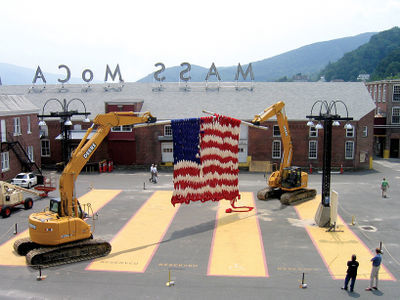
The machine of Sun Yuan and Peng Yu - Can’t Help Myself
[14]

Sun Yuan and Peng Yu - Can’t Help Myself:
https://www.guggenheim.org/video/sun-yuan-peng-yu-tales-of-our-time
the makes have one thing in common and that is machine in relation to human.
To human fairs, thoughts, critics, ideologically, desire, fascination.
“The machine is incapable of preforming any task that is beyond the human Experian’s.
What human’s fears is the unknown, if it is known it can be call the future. “
Peter Stathi's - Satori TV 1998 [15]
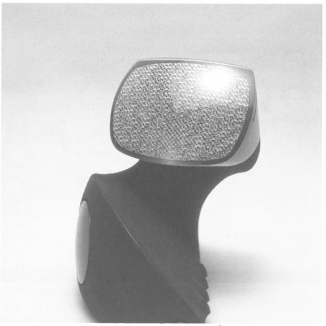
The TV turns his head to fave te viewer when touched, suggests a life where our company will be the electronic appliances
Peter Stathi's - Satori TV 1998 [16]
of the home, which must supply the missing banalities of human contact.
Literature'
Hertzian Tales - Anthony Dunne - ISBN: 9780262042321
Design Noir: The Secret Life of Electronic Objects - Anthony Dunne and Fiona Raby - ISBN-10: 3764365668
Critical Design in Context: History, Theory, and Practices - Matt Malpass - ISBN: 9781472575180
Shaping things- Bruce Sterling - ISBN: 9780262693264
Objects of Desire: Design and Society Since 1750 - Adrian Forty - ISBN: 9780500274125
Objects of desire: the modern still life - Margit Rowell
The Design of Everyday Things - Don Norman - ISBN: 9781452654126
Emotional Design: Why We Love (or Hate) Everyday Things - Don Norman - ISBN 9780465051366 0465051367
The politics of design : a (not so) global manual for visual communication - Ruben Pater - ISBN 9789063694227
Conceptual Art - Peter Osborne - ISBN 0714839302
Experiments
Trying to create a title on the KH-900 Knitting machine - of course the title change but is't not so easy to create a new one
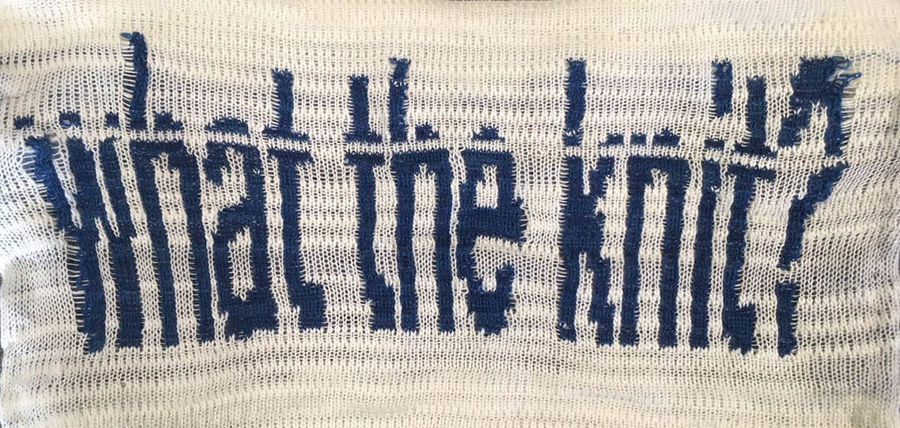
KH-900
When we started with knitting we were experimenting with the ‘normal’ knitting machine, we knitted text and a photo of Instagram and that worked out pretty well. We want to do this because in our proposal we proposed to make knitting pieces based on some social status as Instagram.
We performed these experiments with the brother KH-900. We knew the knitting machine was able to knit pictures but not how accurate it was. We were thinking of creating a wall carpet with the brother knitting machine. We now knew how to knit with the machine, so this was not a technological issue. We want to try out the software, because it is a very limited software where the maker come to your computer to install it. It’s hard to find good software for a knitting program, so we where very curious how this will work. We found the software a bit disappointing to work with, as it was a bit slow, and not very ‘lekker’ designed in a knitting piece. The issue of this machine is that it’s only possible to work with 2 different colours of thread and it is not easy to change this. We where not to enthusiastic to work or experiment more with this machine.
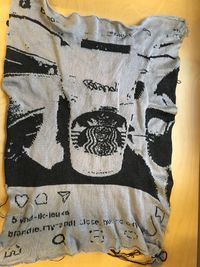
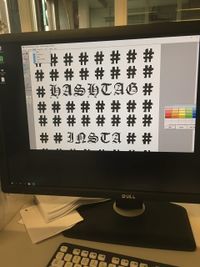
DIY Open-Knit
After this KH-900 we where a bit stuck we were looking on the internet for good knitting books or experimentations. But then there we found this thing with the name: OpenKnit. And feld a bit in love of this DIY.
We want to make this bring back to life, and testing it out. But before we testing it out the machines was testing us if we are strong enough to fix this machine. So this experiment was before we could start with the experiments to cardiopulmonary resuscitation this machine. But while we making we create a new project out of it.
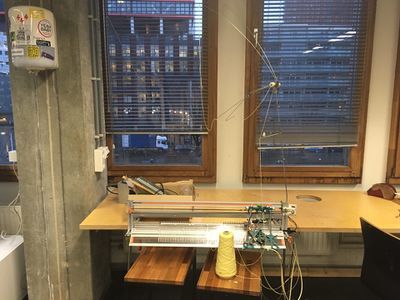
Robot hand – What did we knit?:
This project was one big experience for us. We want to create a robot knitting hands. So we had to find a way how to make this, with material we use for this and what the best was to make this without losing time. We gone test out if it is possible to create in 2,5 weeks make a knitting machine how could create a band or relation with human. Because we work with the DIY Open-Knit and it works really well on human. When we decided to make a human knitting machine, we were experimenting with how people see a knitting machine by asking people to draw a knitting machine.
For us the one of the best things what we did because it’s really affective to see.
The drawings were really interesting, some people didn’t really know what to think of when you say knitting machine and some people actually draw a very similar machine to what we’re going to make.
The true experiment is not the machine but the human at the end of this story. It’s also a social test to see what the humans will do when asked to interact with the machine. Us, being the creators of the machine, were actually the experiment of the machine. It’s not that we where testing out of this machine what affective enough for the human. But if we the makers where resistant for the unknowing supervised of the knitting machine. It was constantly testing and experimenting with us. By pretending the machines are working but then it actually wasn`t and so on and on. For us it was a great search to find why it was acting so slow, or why it did not want to move. But the biggest experiment was an hour before opening the expo. We The whole knitting machine quitted. We were intensively working to repair the machine. Perhaps we humans had a bad aura and the machines was taking it over, or maybe it was to nervous. In the end. but we found out that we only had to turn the power on and off: as if there never had been a problem.
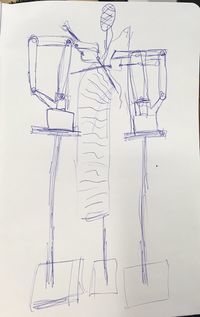
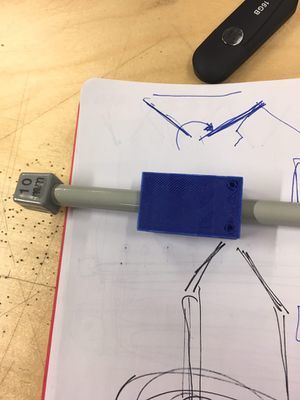
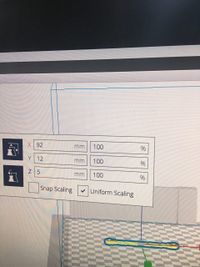
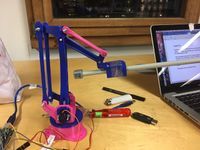
Insights from Experimentation
We started with the knitting machines and from experimenting with them we learned a lot about knitting and special how the knitting machine works. Knowledge we required for developing the Open-Knit machine. With a better understanding of the knitting machine it was easier for us to understand and fix the open knit machine and make our own knitting machine.
The adopted Open-Knit
So if you already know when we saw it for the first time it didn’t look like a knitting machine at all. Open-Knit We found the open kit a machine which is based on the open source idea. So we started the first experiments… this was how do this machine even work? Starting to find a proper documentation of this Open-Knit machine. To follow the documentation, we documentation of this Open-Knit machine and look for what might be missing. After this we started to 3D-print everything and soldering the stuff together. But how works the 3D printer? Fist experiment how to install the layer high of the 3d printer to create stronger 3D-prints for the Open-Knit. After print all this 3D parts we had to disassemble the machine. Before doing that make pictures! So more easy to put everything back. Fixing every wire to the right port and make the Arduino code to work. Checking whether the servos motors were working and moving on it`s own. They documented their work but do not explain it why they make it?
With Open-Knit we can make everything open source but not it did not contain what we want. There is a big gap between the machine and the user. Between the programmer and the people, like us, who use the machine. We ask Gera (master knitting at the fabric station) why she does not use the Open-Knit and she say: ‘’the machine is not based on how knitting works’’ This is the gap between a user, familiar with knitting, and a geek who knows how to build a machine but is unfamiliar with the user. This explains the big difference between the two machines, the knitting machine at the fabric station was made by people who know about knitting and nothing about this open source work.
What this open knit machine was in the first place. This open knit machine [1] was made by a couple of humans as a DIY project. In the instructions [2] there was an explanation of how to build an open knit machine. The open knit was a success and they made a better version [3] A project that is currently on kick-starter. Even the knitting machine has some success they didn’t put everything online like the shield on the Arduino and also the software is pretty shitty. There is no access to create a designer or a designer perspective. Also the open source is lost. When we talked about open source I didn’t know anything about it. For me, I have always some utopic image in my head when I think about a knitting machine. This image in my head is always a pair of robotic hands with kitting needles in it that tries to do a human craft by create a knitting piece.
This same week when we where discuss the knitting machine we had the same imagination though this machine some robot hands how will be knitting. But how?
By doing all this machine work we see more and more the relation between human and machine.
Maybe because we create empathy for this Open-Knit.
The object which we created in the end is between the human and machine. It doesn’t have a conciousness yet but it does have a goal to produce something even if it does not know. Also we had a discussion whether the machine was right or left-handed. It gave some emotional feeling, of course you can say right-handed. But can you give me an example of a right-handed machine? When a human knits you have to choose a side. As a human being you know whether you are left or right handed. A machine or object doesn’t even know what it is till you decide for it.
After working for 3 weeks on this Open-Knit machine we had our package to create our own one.
This machine: What did we knit?
We know for sure we make quick decisions because 2,5 weeks before we decided to do finely a breakpoint to make ore one machine. This was a wake-up call but determined that we want to make this machines.
When we were creating two of the machines there was something weird about it, because both worked differently When we work with the machines we created separate left and right handed machine. We tried to have some influence on it but the machine takes up its own space. Also in the room where I live, when the cars are passing by, the little machine grew a lot bigger and moving objects, giving a voice to this machine. Because the accidental setting of the machines in the windowsill I got a bigger vision of this little machine. It could behave as if it were a child, growing up in the big world where it has to battle to grow and fight to survive in the system. During this process they also created their own personality within my mind. To me the left-handed was always busy and very active. The right handed one was much more modest and did not move as much. Maybe this was because I blew up the Arduino or the USB-port in my laptop, which was meant to give power and movement to the machine`s “hands”or needles.
Artistic/Design Principles
Work day and night, spend so much time it is possible with your idea and find space to create.
And than take a break en looking back on what did I made.
Try different, try to make it small, try to make it big. Just try en experiment with the materials what you find in the room where you are.
Talk to other people, different people, people how don’t give a fuck about design. To give the view not only of your designer perspective.
Re-Perspective your view, what did I make, why did I make, why should I make?
I like to have the ‘rebellion’ in this criteria and discuss this.
When we talk about designing it is already existing (for me), it is already a high standard thing.
Designing is for me the point that something annoying my, something what others don’t get,
make it simple and understandable though the eyes of the participator.
Read a lot, not only designer books. But just books, papers, essay’s, poetry, books for children wherever your interest are in.
Help others always by doing the other thing you can create your one thing.
When is it working? When the design becoming part of there life for a moment, being fascinate by what the design is doing and give a bit freedom of there one humanness too it.
Artistic/Design Proposal
What I did propose is defiantly not what I designed. The design what I propose was the weaving/knitting on a status. This status could be based on Instagram and the tapestry. But also in a art movement the proses create a different view on the work what we had in the mind.
“I want to explore the digital status of people compared to the status of people in the old ages by showing wall carpets”
is something what I typed. After this I draw a lot of proposals, I think a sketchbook full. It’s was only image about what I could weaving or knitting.
In my mind what it a big wall carpet, a product/object making with the machine.
A object how will fill a entire wall or space with knitted or weaving threat. I never thought I used the machine self to created a new piece of art.
Realised work
What we actually make are two machines with a application on it where we put knitting needles in. The machines standing on a transparent platform with a spot in it. The shadow will grow on the wall and visible from the outside. The machines will behave different. The right-handed machine is sofed, modest, quiet and sober. And the left-handed dynamic, alive, curious, pragmatic and combative. What we didn’t plant was the two characters of the machines. There where both program in the way the knitting. This special what always happening on a expo thing, create a new unplanned world. This What did we knit? machine is doing some act, this act is playing constantly. This What did we knit? machines working always even when the human leaves them alone. The machines can’t knit for sure but it is not about the knitting, but about the machine how is doing this work. Most of the time we have distance trough this objects, we don’t see what they do. We humans don’t ask what machines feels. They have to fit in our life’s because they do what we want, what we tell, what we program. Most of this machines can’t we find in our home. It is outside far away of our lives. This machines don’t give to get what you want, but will create a band and view about your relation and the relation between machines. They will create some aura though it and it is possible to touched. It shows his fragility and his clumsiness.
https://vimeo.com/250476622
https://vimeo.com/250463158
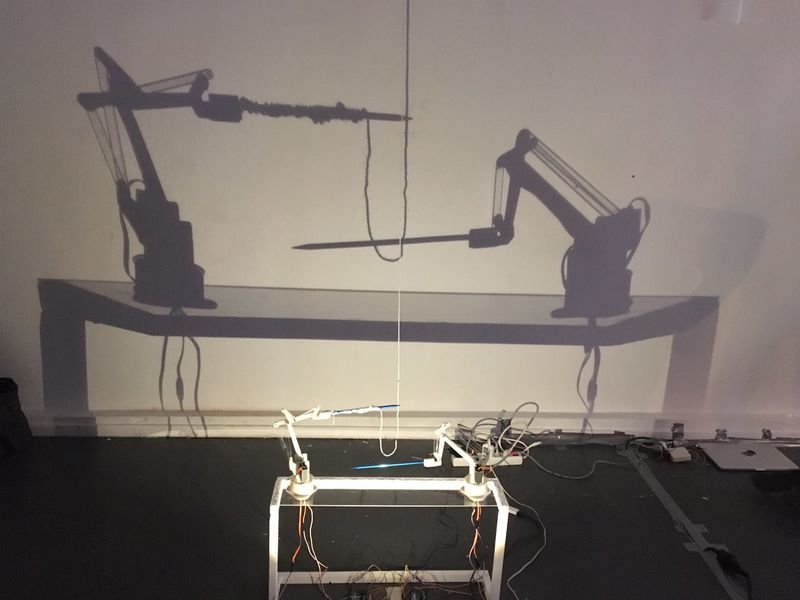
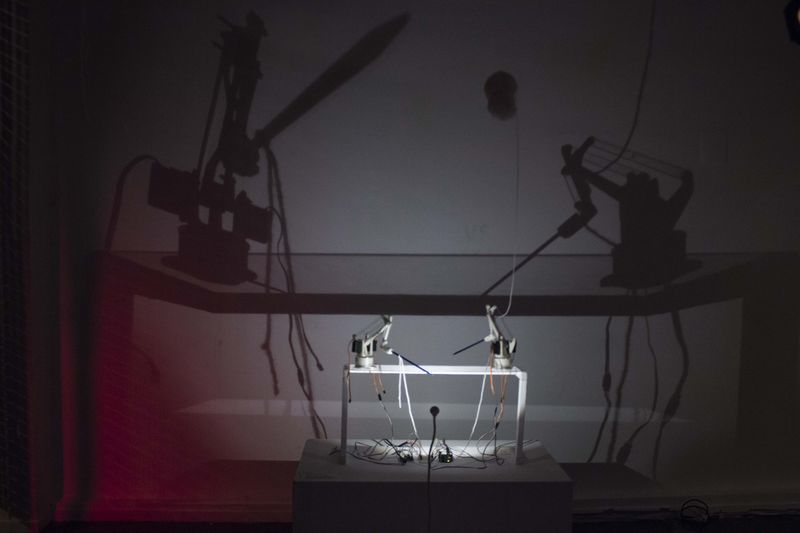
Final Conclusions
What did we knit in the end?
Is it not a bit ironic that we knit nothing in the end? A knitting machine how isn’t able to knit. But is made from our human perspective of knitting. In the first place we see only the knit as an end result. By making a knitting object we create a band with the machines, and not with the knitted work. This is an other way of working. Just by doing and working on a machine take me though an other project to create this little knitting machines.
When I started with this project I never knew I was able to made this. But I’m glad we did. I know that we could it present better for sure! It needs much better light and some platform to present on. Because this project was super fresh an in the starting points of beginning I run out of time at the last day. A bit pity because I want to executed well at the presentation. For myself a bit disappointing, but for sure I have it in my head how I will present it! And I don’t lose this focus. This project was all about empathy, feelings, machines and our human perspectives. The machine can create power to have some feeling for it. During the expo humans where fascinate by the shadow of the machines. The human where a bit in trance for this shadows. First they look at the shadow on the wall and than to the little knitting machines. It’s was very cool to hear al people their voices on this machine. They talk about empathy many people use the word ‘empathy’ till my surprise, and fill in the sad story’s of the machine, there where humans they try to help the machine, some humans start laughing to the machines. And there created complex new story’s. To continue this project and take it a step farther I want to film this reactions of the human out the perspective and reactions are of the machine. To show there reaction’s on machines. Also I want to install some of this machines in people there home. (like in the book of the secret live of object’s) I’m really fascinating what human will do if it this is for a while in their house. I think this project overall fit’s in our human perspective of technologies, machine’s. maybe it is a small piece of this ‘how to be human’ Minor. But we have so many rationality ideologies in us we don’t even know this. We project this on machines and technology. Maybe it it time to show the awareness though humans on there one secret life of the relations with machine’s.
By creating this I would have liked some more support from Suzanne, the communication was a bit weak. Because I heard nothing form Suzanne the winter-break I decided to write this essay alone. I asked her if she could contact me, so it wouldn’t always have to be form my side. But I heard nothing. I used ‘we’ everywhere to show solidarity in this essay. Beside that, this project was also about ‘showing empathy’. Suzanne was also a part of this, and maybe ‘we’ didn’t even make this machine without working together. But that is hypothetic of course. In this Minor I learned a lot about myself. How to deal with ‘I can do things alone’ and make a project alone. It goes a lot faster. I like to work in the early mornings, and also evenings and nights are not a problem. But I can’t project my one passion to work always, to everyone. Suzanne knows a lot about knitting but not so much of technology at some point a bit annoying when you have to start making and not waiting. If you don’t know something I think you have to show some eagerness to learn, and look for some examples or a way to understand and fix it. But this is the point that I can say, I do it alone. I’m capable enough to make, explore, program to what I want. In this project I learned to 3D print, to make a 3D model, work with servo/stepper motors, make circuits, blow up an Arduino, make DIY power adapters, program my own code, learn about robotics and mechanics and lastly studying the topics of machines, objects, behaviours, ideologies, perspectives, and humans. Learning by doing was the best way to find my way through this project, and I found out that I can also do projects alone, even though I was a afraid to do this. For my graduation project I will do this alone.
Bibliography
(1) (http://openknit.org/)http://openknit.org/
(3) (https://en.wikipedia.org/wiki/Utopia_(book)
(4) Design Noir: The Secret Life of Electronic Objects - Anthony Dunne and Fiona Raby - ISBN-10: 3764365668
(5) Hertzian Tales - Anthony Dunne - ISBN: 9780262042321
(6) (Benjamin, W. (1936). The Work of Art in the Age of Mechanical Reproduction. https://en.wikipedia.org/wiki/The_Work_of_Art_in_the_Age_of_Mechanical_Reproduction, 1936, pp. 217-220)
(7) Dunne, A., & Raby, F. (2001). Design Noir: The Secret Life of Electronic Objects. Basel, Zwitserland: Birkhauser.
(8) (9) http://livre-rose.hyper-media.eu/wp-content/uploads/2014/03/valery_conquete_ubiquite.pdf , https://daphnesensei.files.wordpress.com/2014/04/valery_conquest-of-ubiquity1.pdf
(10) (https://www.guggenheim.org/video/sun-yuan-peng-yu-tales-of-our-time)
(11) (Benjamin, W. (1936). The Work of Art in the Age of Mechanical Reproduction. (https://en.wikipedia.org/wiki/The_Work_of_Art_in_the_Age_of_Mechanical_Reproduction), 1936, pp. 217-220)
(12) Dunne, A., & Raby, F. (2013). Speculative Everything. London, United Kingdom: The Mit Press.
(13) https://vimeo.com/28618663
(14) https://www.youtube.com/watch?v=rGV3Y28DtNw&feature=youtu.be
(15) https://dominarum.files.wordpress.com/2013/10/hertzian-tales-23-1.pdf
(14)